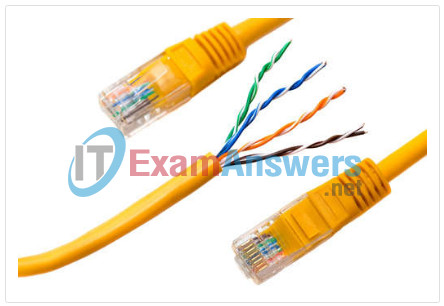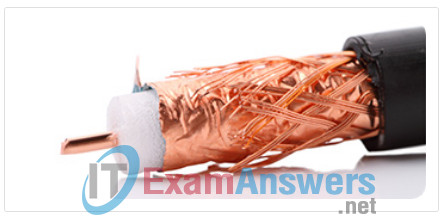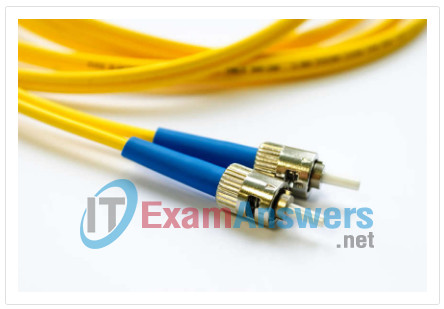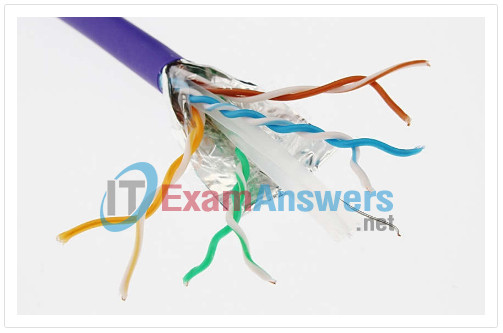4.0 Introduction
4.0.1 Why Should I Take this Module?
Welcome to Build a Simple Peer-to-Peer Network!
A simple peer-to-peer network usually involves directly hard wiring two computers together so that they can share files. Hard wiring requires the correct cables. This module explains the three different types of cables used in networks, how they are connected, and how you can be sure that your peer-to-peer network is working properly. It’s a fun and easy way to get started with networking at your home or school. Why wait?
4.0.2 What Will I Learn in this Module?
This module contains the following:
- 5 Videos
- 2 Labs
- 4 Check Your Understanding activities
- 1 Module Quiz
Module Title: Build a Simple Network
Module Objective: Build a simple home network.
| Topic Title | Topic Objective |
|---|---|
| Ethernet Cabling | Describe Ethernet twisted-pair cables. |
| Coaxial and Fiber-Optic Cabling | Describe coaxial and fiber-optic cabling. |
| Twisted-Pair Operation | Explain how a twisted-pair cable transmits and receives signals. |
| Verify Connectivity | Verify connectivity in a simple routed network. |
4.1 Network Media Types
4.1.2 Three Media Types
Communication transmits across a network on media. The media provides the channel over which the message travels from source to destination.
Modern networks primarily use three types of media to interconnect devices, as shown in the figure:
- Metal wires within cables – Data is encoded into electrical impulses.
- Glass or plastic fibers within cables (fiber-optic cable) – Data is encoded into pulses of light.
- Wireless transmission – Data is encoded via modulation of specific frequencies of electromagnetic waves.
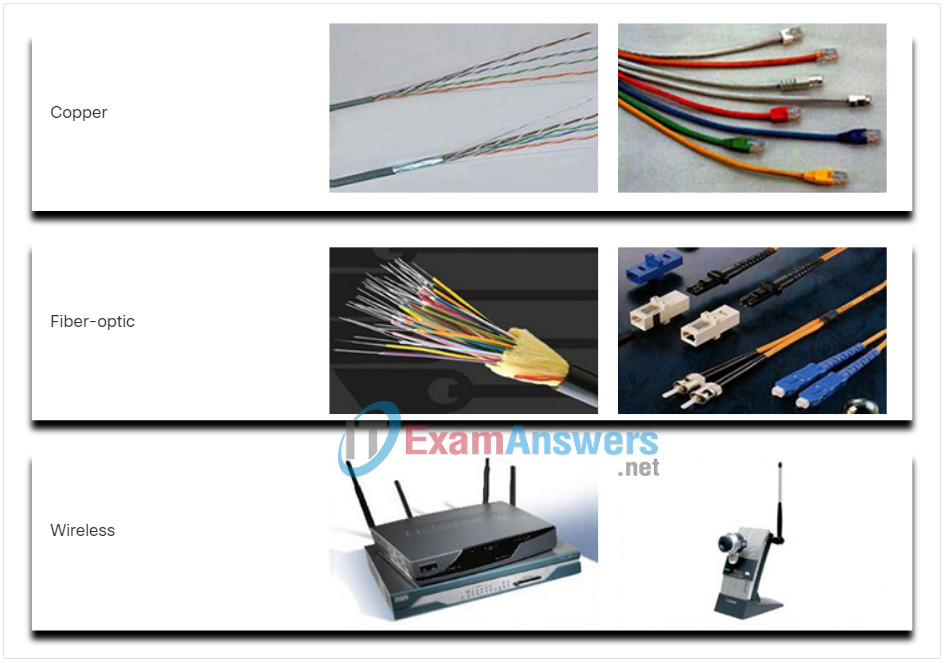
The four main criteria for choosing network media are these:
- What is the maximum distance that the media can successfully carry a signal?
- What is the environment in which the media will be installed?
- What is the amount of data and at what speed must it be transmitted?
- What is the cost of the media and installation?
4.1.3 Common Network Cables
The three most common network cables are twisted-pair, coaxial cable, and fiber-optic cable.
Ethernet Cabling
4.2.1 Twisted-Pair Cables
The networks in most homes and schools are wired with twisted-pair copper cable. This type of cable is inexpensive compared to other types of cabling, and it is readily available. The Ethernet patch cables that you can purchase through the internet or at a retail store are an example of copper twisted-pair cable.
Twisted-pair cables consist of one or more pairs of insulated copper wires that are twisted together and housed in a protective jacket. Like all copper cables, twisted-pair uses pulses of electricity to transmit data.
Data transmission over copper cable is sensitive to electromagnetic interference (EMI), which can reduce the data throughput rate that a cable can provide. Common items in a home that can create EMI include microwave ovens and fluorescent light fixtures.
Another source of interference, known as crosstalk, occurs when cables are bundled together for long lengths. The electrical impulses from one cable can cross over to an adjacent cable. This occurs most frequently when cables are improperly installed and terminated. When data transmission is corrupted due to interference such as crosstalk, the data must be retransmitted. This can degrade the data carrying capacity of the medium.
The figure illustrates how data transmission is affected by interference.

- A pure digital signal is transmitted.
- On the medium, there is an interference signal.
- The digital signal is corrupted by the interference signal.
- The receiving computer reads a changed signal. Notice that a 0 bit is now interpreted as a 1 bit.
4.2.2 Types of Twisted-Pair Cables
There are two commonly installed types of twisted-pair cable:
- Unshielded twisted-pair (UTP) – This is the most commonly encountered type of network cable in North America and many other areas.
- Shielded cables (STP) – These are used almost exclusively in European countries.
Click each twisted-pair type for more information.
Many different categories of UTP cables have been developed over time, as shown in the table. Each category of cable was developed to support a specific technology and most are no longer encountered in homes or offices. The cable types which are still commonly found include Categories 3, 5, 5e, and 6.
| Category | Speed | Features |
|---|---|---|
| Cat 3 UTP | 10 Mbps at 16 MHz |
|
| Cat 5 UTP | 100 Mbps at 100 MHz | Manufactured with higher standard than Cat 3 to allow for higher data transfer rates |
| Cat 5e UTP | 1000 Mbps at 100 MHz |
|
| Cat 6 UTP | 1000 Mbps at 250 MHz |
|
All categories of data grade UTP cable are traditionally terminated into an RJ-45 connector. There are still some applications that require the smaller RJ-11 connector, such as analog phones and some fax machines. In the figure below, an example of an RJ-11 connector is on the left. The RJ-45 connector is on the right.
RJ-11 and RJ-45 Connectors

4.3 Coaxial and Fiber-Optic Cabling
4.3.1 Cable TV and Satellite Cables
Like twisted-pair, coaxial cable (or coax) carries data in the form of electrical signals. It provides improved shielding compared to UTP and can therefore carry more data. Coaxial cable is usually constructed of either copper or aluminum. It is used by cable television companies to provide service and for connecting the various components that make up satellite communication systems. You are probably familiar with the coaxial cables used to connect a TV set to the signal source, be it a cable TV outlet, satellite TV, or conventional antenna in your home. With the addition of a cable modem, the cable television provider can offer data and internet service, as well as television signals and telephone over the same coaxial cable.
Although coax has improved data carrying characteristics, twisted-pair cabling has replaced coax in local area networking uses. Among the reasons for the replacement is that compared to UTP, coax is physically harder to install, more expensive, and harder to troubleshoot.
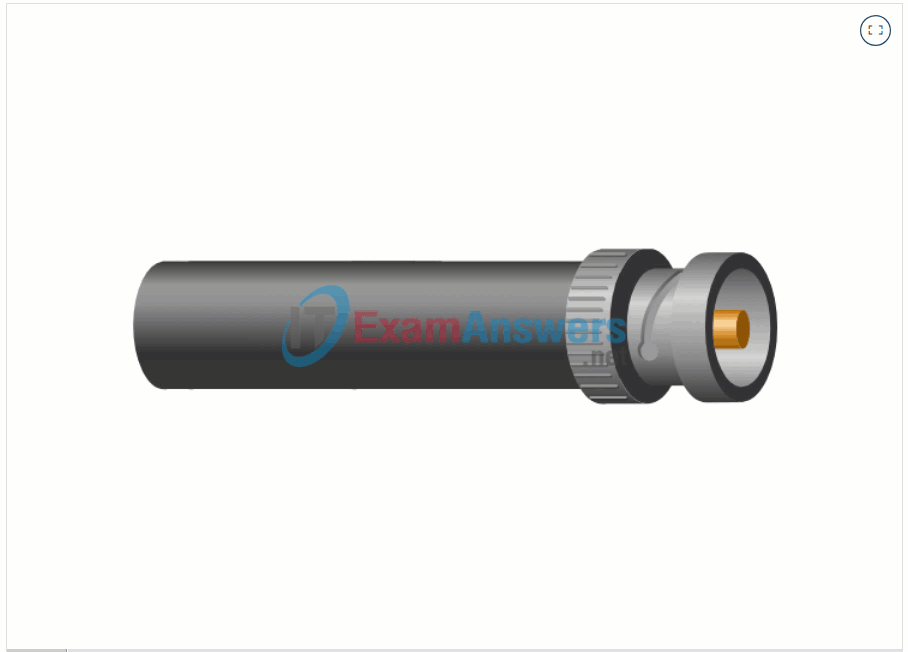
4.3.2 Fiber-Optic Cables
Unlike UTP and coax, fiber-optic cables transmit data using pulses of light. Although not normally found in home or small business environments, fiber-optic cabling is widely used in enterprise environments and large data centers.
Fiber-optic cable is constructed of either glass or plastic, neither of which conducts electricity. This means that it is immune to EMI and RFI, and is suitable for installation in environments where interference is a problem. Fiber connections are a good choice to extend networks from one building to another, both because of distance considerations and because fiber cables are more resistant to outdoor environmental conditions than copper cables. Each fiber-optic circuit is actually two fiber cables. One is used to transmit data; the other is used to receive data.
The figure shows the structure of a fiber-optic cable.

In the figure above, the parts of a fiber-optic cable are as follows:
- Jacket – Typically a PVC jacket that protects the fiber against abrasion, moisture, and other contaminants. This outer jacket composition can vary depending on the cable usage.
- Strengthening Material – Surrounds the buffer, prevents the fiber cable from being stretched when it is being pulled. The material used is often the same material used to produce bulletproof vests.
- Buffer – Used to help shield the core and cladding from damage.
- Cladding – Made from slightly different chemicals than those used to create the core. It tends to act like a mirror by reflecting light back into the core of the fiber. This keeps light in the core as it travels down the fiber.
- Core – The core is actually the light transmission element at the center of the optical fiber. This core is typically silica or glass. Light pulses travel through the fiber core.
Fiber-optic cables can reach distances of several miles or kilometers before the signal needs to be regenerated. Either lasers or light emitting diodes (LEDs) generate the light pulses that are used to represent the transmitted data as bits on the media. In addition to its resistance to EMI, fiber-optic cables support a large amount of bandwidth, making them ideally suited for high-speed data networks. Bandwidth on fiber-optic links can reach speeds of 100 Gbps and is continually increasing as standards are developed and adopted. Fiber-optic links are found in many corporations and are also used to connect ISPs on the internet.
4.4 Twisted-Pair Operation
4.4.1 Twisted-Pair Wiring Schemes
Have you ever looked closely at the plastic RJ-45 connector at the end of an Ethernet patch cable? Did you ever wonder why each of the wires terminating in the connector has a specific color or pattern? The color coding of the wire pairs in an UTP cable is determined by the type of standard that is used to make the cable. Different standards have different purposes and are closely governed by the standards organizations.
For typical Ethernet installations, there are two standards that are widely implemented. The TIA/EIA organization defines two different patterns, or wiring schemes, called T568A and T568B, as shown in the figure. Each wiring scheme defines the pinout, or order of wire connections, on the end of the cable.
On a network installation, one of the two wiring schemes (T568A or T568B) should be chosen and followed. It is important that the same wiring scheme is used for every termination in that project.
T568A and T568B Standards
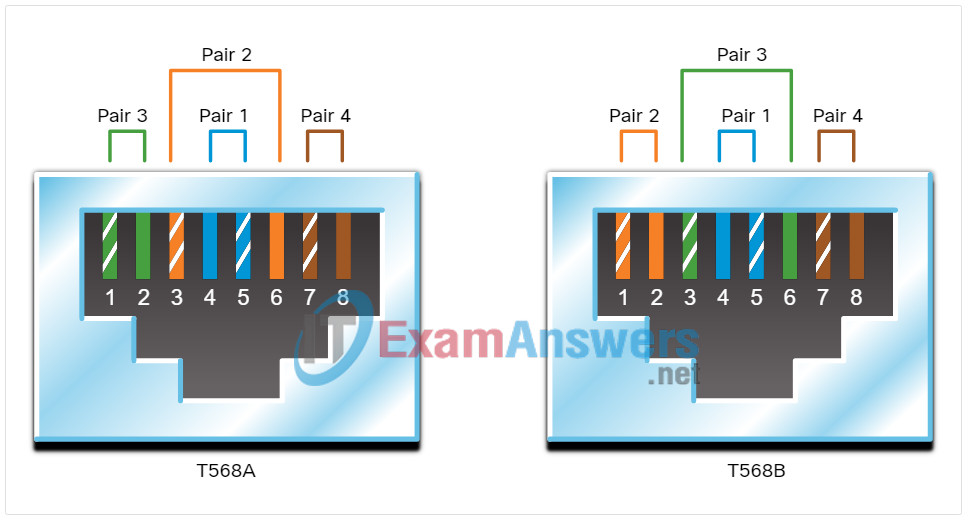
4.4.2 Twisted-Pair Transmit and Receive Pairs
Ethernet NICs and the ports on networking devices are designed to send data over UTP cables. Specific pins on the connector are associated with a transmit function and a receive function. The interfaces on each device are designed to transmit and receive data on designated wires within the cable.
When two devices are directly connected using an UTP Ethernet cable, it is important that the transmit function and the receive function on each end of the cable are reversed. One device sends data on a specific set of wires and the device on the other end of the cable listens for the data on the same wires.
Two devices that use different wires for transmit and receive are known as unlike devices. They require a straight-through cable to exchange data. Straight-through cables have the same color patterns on both ends of the cable.
Devices that are directly connected and use the same pins for transmit and receive, are known as like devices. They require the use of a crossover cable in order to reverse the transmit function and receive function so that the devices can exchange data.
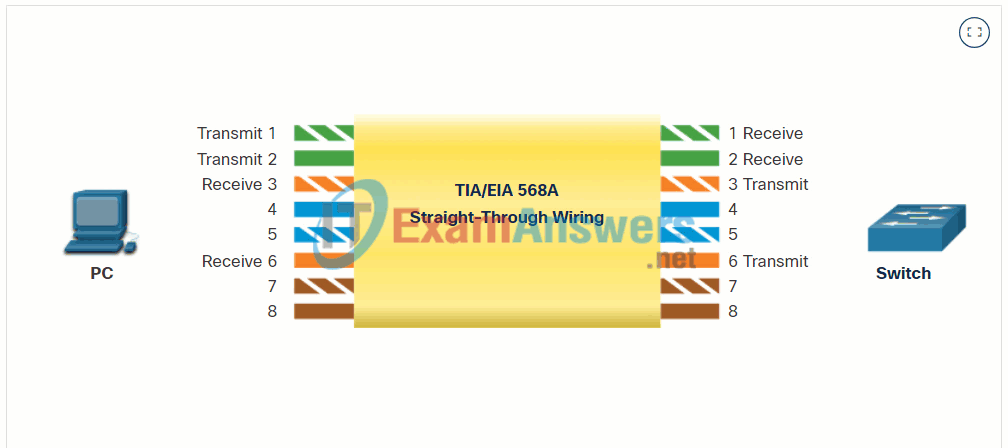
4.5 Verify Connectivity
4.5.2 Using the ping Command
Every device that sends messages across the internet must have an Internet Protocol (IP) address to identify it to the other devices in the network. IP addresses are assigned by network administrators. When a new device is added to a network, or if an existing device is having problems, it may be necessary to test the network to determine if the IP address assigned to the device can be reached by other devices on the network.
The ping utility tests end-to-end connectivity between the IP address of the source of the message and the IP address of its destination. It measures the time that it takes test messages to make a round trip from the source to the destination, and whether the transmission is successful. However, if the test message does not reach the destination, or if delays are encountered along the way, there is no way to determine where the problem is located.
The format of the ping command is universally implemented. Almost all network attached devices provide a way to perform a ping test. The format of the ping command is ping x.x.x.x, where x.x.x.x is an IP address or domain name:
For example, ping 192.168.30.1.
Ping to a Remote Host
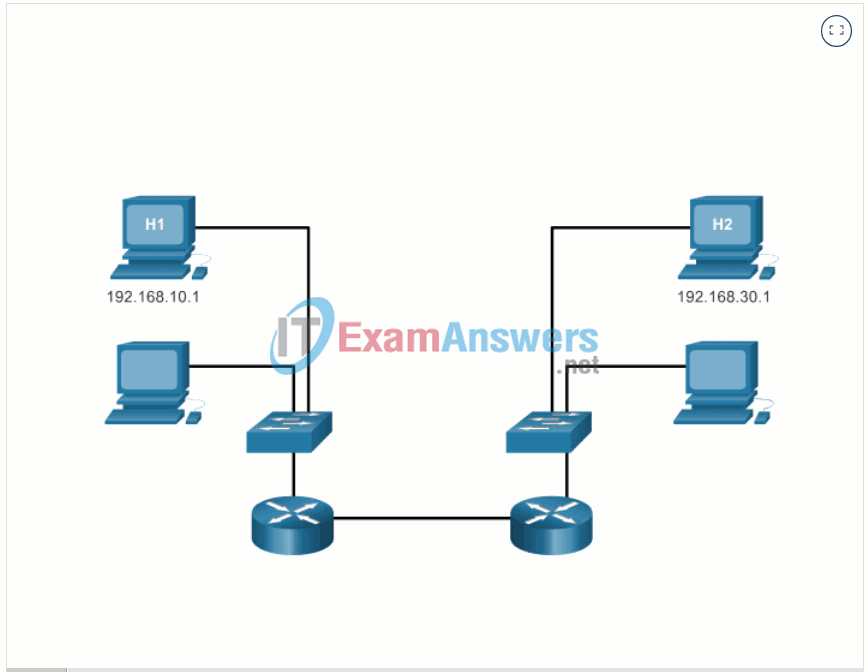
4.5.3 The traceroute Command
The internet is not really a place; it is the interconnection of many different networks that provide services to the users. We can see this connectivity by using a network utility call traceroute.
As shown in the figure, the traceroute utility traces the route a message takes from its source to the destination. Each individual network through which the message travels is referred to as a hop. The traceroute command displays each hop along the way and the time it takes for the message to get to that network and back.
If a problem occurs, use the output of the traceroute utility to help determine where a message was lost or delayed. The traceroute utility is called tracert in the Windows environment.
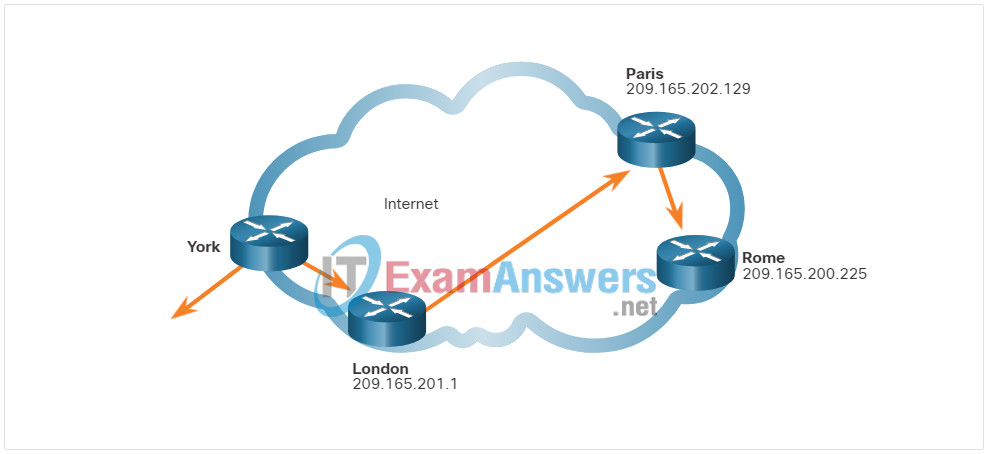
York# traceroute ROME Type escape to abort. Tracing the route to Rome (209.165.200.225) 1. LONDON (209.165.201.1) 8msec 8 msec 4 msec 2. PARIS (209.165.202.129) 8 msec 8 msec 8 msec 3. ROME (209.165.200.225) 8msec 8 msec 4 msec York#
4.5.7 Lab – Build a Simple Network
In this lab, you will complete the following objectives:
- Identify cables and ports for use in the network.
- Cable a physical lab topology.
- Enter static IP address information on the LAN interface of the hosts.
- Verify that PCs can communicate using the ping utility.
4.5.8 Lab – Trace a Route
In this lab, you will complete the following objectives:
- Test network connectivity using ping.
- Trace a route to a remote server using Windows tracert.
- Trace a route to a remote server using web-based tools and software tools.
- Compare traceroute results.
4.6 Build a Simple Network Summary
4.6.1 What Did I Learn in this Module?
Network Media Types
Modern networks primarily use three types of media to interconnect devices and to provide the pathway over which data can be transmitted: copper wires within cables, glass or plastic fibers (fiber-optic cable), and wireless transmission. The four main criteria for choosing network media are: the distance the media can successfully carry a signal, the environment in which the media is to be installed, the amount of data and the speed at which it must be transmitted, and the cost of the media and installation.
Twisted-pair is the most common network cable. The wires are grouped in pairs and twisted together to reduce interference. Coaxial cable is usually made of copper or aluminum. It has a single rigid core surrounded by a layer of insulation, braided metal shielding, and a protective jacket. Glass or plastic fiber-optic cable core has a diameter similar to a human hair. These cables can carry digital information at high speeds over long distances.
Ethernet Cabling
Twisted-pair cables consist of one or more pairs of insulated copper wires that are twisted together and housed in a protective jacket. Like all copper cables, twisted-pair uses pulses of electricity to transmit data. Data transmission over copper cable is sensitive to EMI, which can reduce the data throughput rate that a cable can provide. Common items in a home that can create EMI include microwave ovens and fluorescent light fixtures. Another source of interference, known as crosstalk, occurs when cables are bundled together for long lengths. The electrical impulses from one cable can cross over to an adjacent cable.
There are two commonly installed types of twisted-pair cable: UTP (most commonly used type) and STP (used most often in European countries). UTP cable types which are still commonly found include Categories 3, 5, 5e and 6. All categories of data grade UTP cable are traditionally terminated into an RJ-45 connector.
Coaxial and Fiber-Optic Cabling
Like twisted-pair, coaxial cable (or coax) carries data in the form of electrical signals. It provides improved shielding compared to UTP and can therefore carry more data. Although coax has improved data carrying characteristics, twisted-pair cabling has replaced coax in LANs because coax is harder to install, more expensive, and harder to troubleshoot.
Unlike UTP and coax, fiber-optic cables transmit data using pulses of light. Fiber-optic cable is constructed of either glass or plastic, neither of which conducts electricity. This means that it is immune to EMI and RFI, and is suitable for installation in environments where interference is a problem. Fiber connections are a good choice to extend networks from one building to another, both because of distance considerations and because fiber cables are more resistant to outdoor environmental conditions than copper cables. Each fiber-optic circuit is actually two fiber cables. One is used to transmit data; the other is used to receive data. Either lasers or light emitting diodes (LEDs) generate the light pulses that are used to represent the transmitted data as bits on the media. In addition to its resistance to EMI, fiber-optic cables support a large amount of bandwidth, making them ideally suited for high-speed data networks.
Twisted Pair Operation
The color coding of the wire pairs in an UTP cable are determined by the type of standard that is used to make the cable. Different standards have different purposes and are closely governed by the standards organizations.
For typical Ethernet installations, there are two widely implemented standards. The TIA/EIA organization defines two different patterns, or wiring schemes, called T568A and T568B. Each wiring scheme defines the pinout, or order of wire connections, on the end of the cable. It is important that the same wiring scheme is used for every termination in an installation.
Ethernet NICs and the ports on networking devices are designed to send data over UTP cables. Specific pins on the connector are associated with a transmit function and a receive function. The interfaces on each device are designed to transmit and receive data on designated wires within the cable. Two devices that use different wires for transmit and receive are known as unlike devices. They require a straight-through cable to exchange data. Straight-through cables have the same color patterns on both ends of the cable. Devices that are directly connected and use the same pins for transmit and receive are known as like devices. They require the use of a crossover cable in order to reverse the transmit function and receive function so that the devices can exchange data.
Verify Connectivity
The ping utility tests end-to-end connectivity between the IP address of the source of the message and the IP address of its destination. It measures the time that it takes test messages to make a round trip from the source to the destination and whether the transmission is successful.
The traceroute utility traces the route a message takes from its source to the destination. Each individual network through which the message travels is referred to as a hop. The traceroute command displays each hop along the way and the time it takes for the message to get to that network and back. The traceroute utility is called tracert in the Windows environment.

